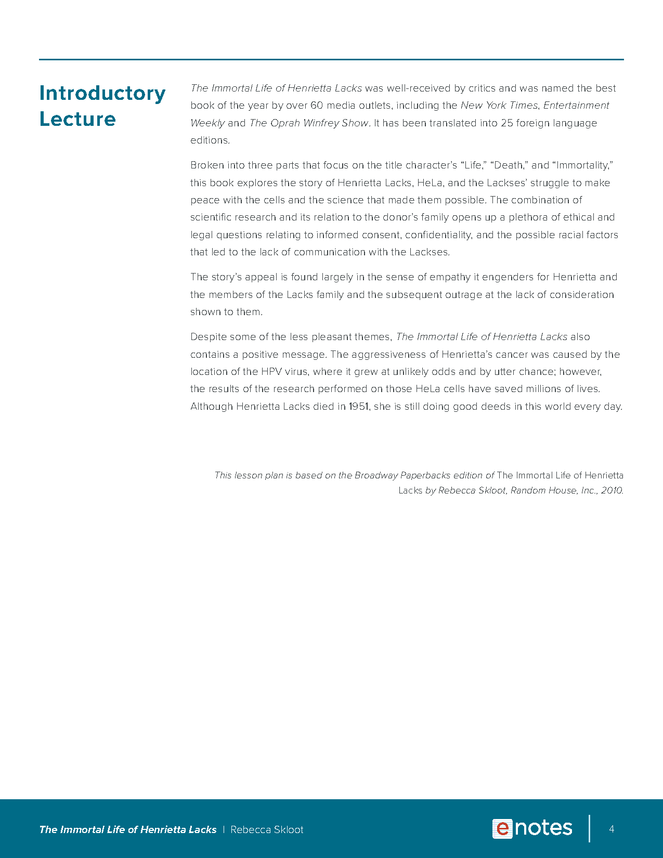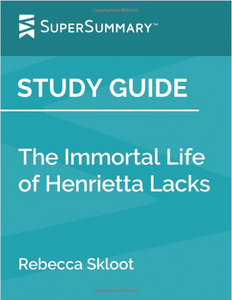

- THE IMMORTAL LIFE OF HENRIETTA LACKS STUDY GUIDE ANSWERS FULL
- THE IMMORTAL LIFE OF HENRIETTA LACKS STUDY GUIDE ANSWERS TRIAL
But before she died, a surgeon took samples of her tumor and put them in a petri dish. Henrietta died in 1951 from a vicious case of cervical cancer, he told us. He grinned and spun to face the board, where he wrote two words in enormous print: HENRIETTA LACKS. “We learned that by studying cancer cells in culture,” Defler said. Mitosis goes haywire, which is how it spreads. Just one enzyme misfiring, just one wrong protein activation, and you could have cancer. That genome tells cells when to grow and divide and makes sure they do their jobs, whether that’s controlling your heartbeat or helping your brain understand the words on this page.Īll it takes is one small mistake anywhere in the division process for cells to start growing out of control, he told us. The nucleus is the brains of the operation inside every nucleus within each cell in your body, there’s an identical copy of your entire genome. All the while, little cytoplasmic factories work 24/7, cranking out sugars, fats, proteins, and energy to keep the whole thing running and feed the nucleus.
THE IMMORTAL LIFE OF HENRIETTA LACKS STUDY GUIDE ANSWERS FULL
It’s crammed full of molecules and vessels endlessly shuttling enzymes and sugars from one part of the cell to another, pumping water, nutrients, and oxygen in and out of the cell. Under the microscope, a cell looks a lot like a fried egg: It has a white (the cytoplasm) that’s full of water and proteins to keep it fed, and a yolk (the nucleus) that holds all the genetic information that makes you you. The cytoplasm buzzes like a New York City street. They make up all our tissues-muscle, bone, blood-which in turn make up our organs. What he wanted us to understand was that cells are amazing things: There are about one hundred trillion of them in our bodies, each so small that several thousand could fit on the period at the end of this sentence.

Yes, Defler said, we had to memorize the diagrams, and yes, they’d be on the test, but that didn’t matter right then. (Credit: Tom Deerinck/National Institutes of Health) Multiphoton fluorescence image of stained HeLa cells. In her prime, Henrietta herself stood only a bit over five feet tall. Another scientist calculated that if you could lay all HeLa cells ever grown end-to-end, they’d wrap around the Earth at least three times, spanning more than 350 million feet. One scientist estimates that if you could pile all HeLa cells ever grown onto a scale, they’d weigh more than 50 million metric tons-an inconceivable number, given that an individual cell weighs almost nothing. There’s no way of knowing exactly how many of Henrietta’s cells are alive today. READ MORE: The Tuskegee Experiment: The Infamous Syphilis Study I’m pretty sure that she-like most of us-would be shocked to hear that there are trillions more of her cells growing in laboratories now than there ever were in her body. I’ve tried to imagine how she’d feel knowing that her cells went up in the first space missions to see what would happen to human cells in zero gravity, or that they helped with some of the most important advances in medicine: the polio vaccine, chemotherapy, cloning, gene mapping, in vitro fertilization. I’ve spent years staring at that photo, wondering what kind of life she led, what happened to her children, and what she’d think about cells from her cervix living on forever-bought, sold, packaged, and shipped by the trillions to laboratories around the world.
THE IMMORTAL LIFE OF HENRIETTA LACKS STUDY GUIDE ANSWERS TRIAL
My father gave consent, so his story is of course very different from Henrietta’s, but as a child with a father in a clinical trial I became obsessed with the question of who are the individuals behind the research and how does that impact them and their families? My next book returns to related ground: Animals, research, and ethics-another area of science where everyone benefits, and where it’s important to ask where to draw the line between the benefit of science and the impact on research subjects. I imagine that’s because I was a kid watching her own parent be part of scientific research and experiencing the ups and downs of that: The hope that it will help, the fear of what might happen, and in my dad’s case, the pain of research going wrong. When I first heard about Henrietta I thought: I wonder if she had any kids and what they think about those cells. He enrolled in a clinical trial that had some ethical problems, and I watched it all. It was terrifying-no one knew what was wrong with him, and it left him permanently disabled.

He lost his memory, he couldn’t move from a recliner in the living room. Because of a viral infection, one day he went from being my healthy marathon-running dad to being incapacitated.

When I was 16, the year I first learned about HeLa cells, my father got very sick.


 0 kommentar(er)
0 kommentar(er)
